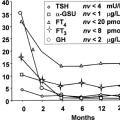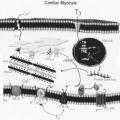Thyrotoxic Storm
Leonard Wartofsky
Thyrotoxic storm or crisis is a rare, life-threatening syndrome characterized by exaggerated clinical manifestations of thyrotoxicosis (1). Its incidence is not precisely known because there are no widely accepted criteria for its diagnosis. However, a scoring system to indicate the diagnosis has been proposed (2) on the basis of signs and symptoms and is proving useful (Table 30.1). It appears that the syndrome is much less common today than in the past, due to earlier diagnosis and treatment of thyrotoxicosis, and storm may account for no more than 1% to 2% of hospital admissions for thyrotoxicosis (3,4). On the basis of routine thyroid function tests, most patients with thyrotoxic storm are indistinguishable from those with uncomplicated thyrotoxicosis. Therefore, the diagnosis typically is a clinical one, based on the severity of the symptoms and signs of thyrotoxicosis and presence of functional decompensation of one or more organ systems in a thyrotoxic patient. Because of the potential high mortality, it is often necessary to begin treatment without waiting for biochemical confirmation of the diagnosis of thyrotoxicosis.
The cardinal manifestations of thyrotoxic storm may not all be present or may be present in variable degree, and can include fever (temperature usually >102°F), tachycardia (out of proportion to the fever), gastrointestinal dysfunction (including nausea, vomiting, diarrhea, and, in severe cases, jaundice), and central nervous system (CNS) dysfunction, varying from marked hyperirritability and anxiety to confusion to apathy and even coma. Prompt diagnosis and vigorous therapy are required to avoid a fatal outcome; the mortality rates of hospitalized patients have ranged from 10% to 75% (5,6,7).
Clinical Features
Most patients with thyrotoxic storm have rather obvious symptoms and signs of thyrotoxicosis, including goiter and, in the presence of Graves’ disease, ophthalmopathy, although it can occur in patients with masked or apathetic thyrotoxicosis. There is usually a several-month history of untreated or partially treated thyrotoxicosis, but in an occasional patient the onset of thyrotoxicosis seems to be recent. Typically, those cases of more recent onset will be more rapidly progressive in severity of manifestations.
Two types of events have been associated with the precipitation of thyrotoxic crisis (Table 30.2). One is an intercurrent illness or injury that exacerbates the effects of thyrotoxicosis either systemically or on one or more particular organ systems. The other, now rare, is an acute event that suddenly increases thyroid secretion. This latter situation is best exemplified by the occurrence of thyrotoxic storm soon after thyroidectomy, which was relatively common before the need for preoperative antithyroid therapy was recognized. The presumed explanation was increased thyroxine (T4) and triiodothyronine (T3) release caused by manipulation of the thyroid gland, compounded by the systemic effects of surgical stress. The rare occurrence of thyrotoxic storm after radioiodine therapy for thyrotoxicosis is the modern counterpart of this phenomenon.
Many illnesses and trauma, including the trauma of surgery, can precipitate thyrotoxic storm in patients with previously undiagnosed or poorly treated thyrotoxicosis, and storm has been seen following the trauma of an automobile accident. Rare cases of storm have been noted after intoxication with organophosphates (8), exposure to neurotoxins (9), or after chemotherapy for a coincident malignancy (10). The most common precipitating event now is probably an infection, and in a patient with thyrotoxicosis and infection it is difficult if not impossible to determine whether fever and tachycardia herald impending crisis or merely reflect the infection. Excessive diaphoresis with high fever out of proportion to the infection may be a clue to the presence of thyrotoxic storm. Indeed, when it is not recognized and treated, the fever may reach an extremely high and life-threatening level. An exception to this may be the elderly “apathetic” patient or those with concomitant pituitary or adrenal insufficiency (11). Signs and symptoms of CNS dysfunction indicative of metabolic encephalopathy, with anxiety, emotional lability, restlessness, agitation, seizure, confusion, psychosis, and coma, are common, and are important further clues to the diagnosis. The encephalopathy in one case was associated with magnetic resonance imaging (MRI) typical of limbic encephalitis (12). In other cases, thyrotoxic storm was associated with status epilepticus and stroke, or with bilateral basal ganglia infarction, and there may be a greater risk of superior sagittal thrombosis in these patients (13) presumably secondary to a hypercoagulable state (14,15). Storm associated with hydatidiform mole (16), due to subacute thyroiditis (17), metastatic thyroid carcinoma (18,19), or to excessive ingestion of thyroid hormone (20,21) have been reported but must be extremely rare.
Table 30.1 Diagnostic Criteria for Thyrotoxic Crisis | ||||||||||||||||||||||||||||||||||||||||||||||||||||||||||||||||||||||||||||||||||||||||||||||||
|---|---|---|---|---|---|---|---|---|---|---|---|---|---|---|---|---|---|---|---|---|---|---|---|---|---|---|---|---|---|---|---|---|---|---|---|---|---|---|---|---|---|---|---|---|---|---|---|---|---|---|---|---|---|---|---|---|---|---|---|---|---|---|---|---|---|---|---|---|---|---|---|---|---|---|---|---|---|---|---|---|---|---|---|---|---|---|---|---|---|---|---|---|---|---|---|---|
| ||||||||||||||||||||||||||||||||||||||||||||||||||||||||||||||||||||||||||||||||||||||||||||||||
In addition to marked sinus tachycardia, atrial tachyarrhythmias may be present, as may symptoms and signs of congestive heart failure. Although the latter is more likely to occur in elderly patients with underlying heart disease, it can occur in relatively young or middle-aged patients with no known antecedent (or subsequently demonstrable) heart disease. A reversible dilated cardiomyopathy may be the etiology of heart failure (22) and thyrotoxic crisis has been seen in the setting of myocardial infarction (23). Systolic hypertension with widened pulse pressure is likely to be noted in most patients, at least initially, although some patients have postural hypotension, particularly those with volume depletion due to vomiting or diarrhea, and vascular collapse may supervene. Other gastrointestinal manifestations include presentation as an acute abdomen or intestinal obstruction, or with
diffuse abdominal pain, hepatomegaly, splenomegaly, and various abnormalities in liver function. The liver may be tender, as a result of either congestion or hepatic necrosis. The presence of jaundice is a poor prognostic sign.
diffuse abdominal pain, hepatomegaly, splenomegaly, and various abnormalities in liver function. The liver may be tender, as a result of either congestion or hepatic necrosis. The presence of jaundice is a poor prognostic sign.
Laboratory Findings
Serum total T4 and T3 concentrations and thyroid radioiodine uptake values are high in patients with thyrotoxic storm, but not necessarily more so than in patients with uncomplicated thyrotoxicosis. Serum free T4 and T3 concentrations are also high, and may be on average slightly higher than in patients with uncomplicated thyrotoxicosis (24). On the other hand, serum T3 concentrations may be normal in patients who have been sick for more than a few days, due to the decrease in extrathyroidal conversion of T4 to T3 that occurs in many nonthyroidal illnesses (25,26) (see section on nonthyroidal illness in Chapter 11C).
In a patient with previously undiagnosed thyrotoxicosis, the most rapid confirmation of the diagnosis may be obtained by measuring thyroid radioiodine uptake 2 hours after administration of radioiodine or thyroid pertechnetate uptake 20 or 30 minutes after administration of pertechnetate (see Chapter 12). It should be possible to obtain the results of serum T4 and thyrotropin (TSH) determinations in an hour or two on an emergency basis in many hospitals.
Table 30.2 Events Associated with the Onset of Thyrotoxic Storm | |||||||||||||||||||||
|---|---|---|---|---|---|---|---|---|---|---|---|---|---|---|---|---|---|---|---|---|---|
|
Stay updated, free articles. Join our Telegram channel

Full access? Get Clinical Tree








